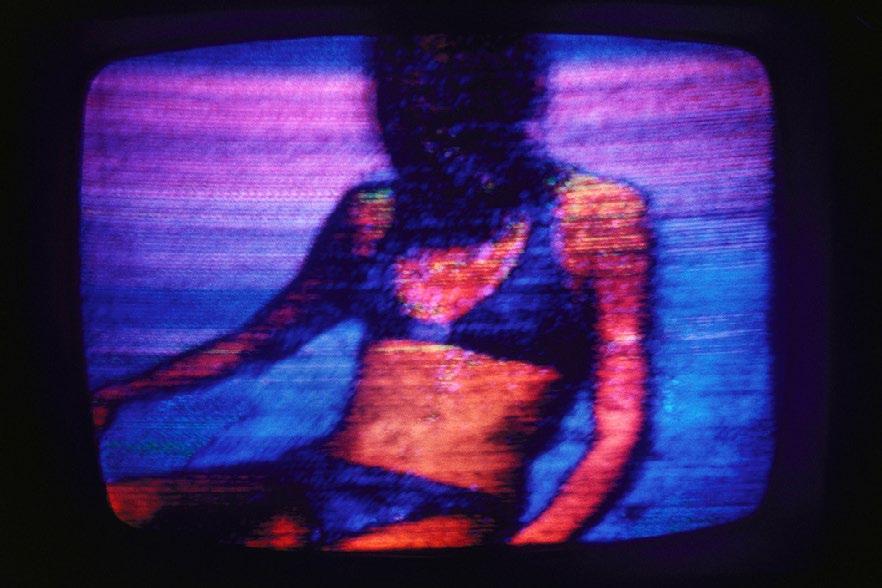
4 minute read
Circus TV
from Balkan Beats 31
by Pablo Rubio or the art of doing fear as a spectacle
A reflection on the power of the mass media over its audience, exploiting instinctual reactions to content such as morbidity in unpleasant events.
Advertisement
One afternoon in September 2001, the 5-yearold boy that I was was returning home after a bike ride. School had not yet started and the remains of a hot summer were still in the air. When I arrived at the dining room I found my family gathered around the television. Two immense towers were spitting out puffs of fire, collapsing like a stack of cards. The streets of that city, which I had seen before in many movies, were now a turmoil of blood, dust and tears. How can I keep this memory so vivid and not others? Harry Gruyaert. TV shot of a couple in soap opera. 1972
© Magnum Photos
Fear is one of the most powerful and primitive emotions humans possess. It helps us stay alert and avoid danger. Being 5 years old and seeing violent images, in a western setting, having as protagonists people with a familiar look, induces an irrational fear and, at the same time, a certain curiosity. We are mortal creatures and we know it, but when we are only indirect witnesses, mere spectators, we find a certain happiness in being spared; “the dead one is not me”.

The Twin Towers catastrophe in New York is a good example of one of the other sides of the coin of fear: morbidity. Apart from the colossal dimensions that this event represented, at a social, political and economic level, every September 11, when the media remind us of these images, we relive the fear and at the same time indulge in the curiosity, morbidity’s foundation. Throughout history, man has wilfully witnessed violent death: rituals, the Roman circus, public executions in squares and, with the arrival of journalism, double-page images of mass murders. But it is with the arrival of the cinema that the seed of morbidity blossoms. Seeing images in movement, explicit and concise, as if we were looking through a peephole, like Hitchcock’s Norman Bates, gave us exceptional power, which had its culmination with the arrival of television. Over the years I continued looking at the screen with curiosity and at the same time a critical eye. Reports about crime in slums, where instead of denouncing a social problem, showing a realistic cause, minorities are pointed out as the culprits and their actions are trivialised. Live broadcasts of funerals after sordid murders, working with what is supposed to be private, spectacularization of the pain of others in Prime Time. Events are oversized to compete with other media and generate audiences. And this is why morbidity is used. To convince the viewer that it’s an image they need to see. So, between pauses, there will be advertising to ensure the monetization. Television, like any other capitalist element, uses sophisticated strategies to do business. News shows or any other programs with such content play a double role. They disguise the show as serious and truthful information delivered in a way that will influence the opinion of the public. In other words, lurid facts with attractive hosts, who will not make us feel guilty; the act of watching television is private, no one will see us doing it. Every day we watch from our homes events that should not interest us and should not be Harry Gruyaert. Television Broadcast. Great Britain and France. 1972 © Magnum Photos
shown. If there is no violence, tears will be added to the final product. The suffering of others is very newsworthy, and therefore voraciously consumed. All this relegates truthful, honest and critical journalism to the background. To the five W’s of journalism (who, what, when, where and why) are added others like: why didn’t the mother of the murdered man cry enough at the funeral? Who is the uncle of the mother of the murderer’s brother? Do you want to see, after the advertisements, how the child was assassinated? The code of ethics is set aside, and the role of social justice is assumed, “speculating” with prestige. If on the one hand the root of morbidity is death, under the form of violence, on the other hand we have sex. Paraphilias, perversions and sexual crimes generate an impudent interest, as they remain a taboo subject, something “forbidden”. It is women who are the most affected by this. The media does not hesitate to appeal to objectification, knowing that this will generate interest. The fact that rape and torture can be trivialized and generate profits really does show us how far our society has progressed regarding the role of women in it. The media pretends that it is the viewer who demands this information. They actively engage in attracting attention, manipulating our perception and appealing to our basest instincts. Until society actively demands healthy, verified information that isn’t there to keep you in front of the TV for 24 hours, throwing blood in your face to generate profit, they will continue giving us our daily ration of bread and circus.
Harry Gruyaert. Paris, France.

© Magnum Photos










